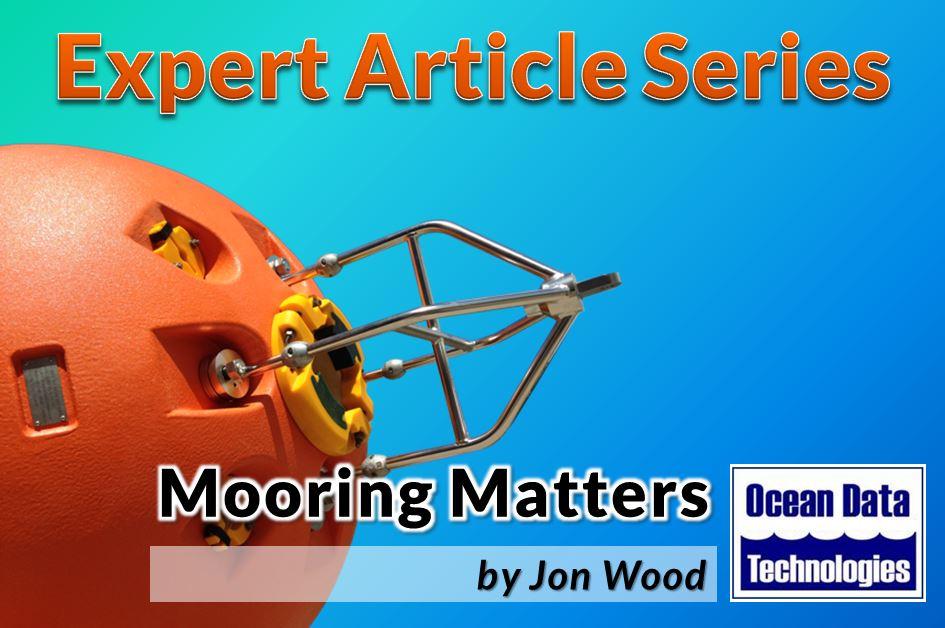For the first of a series of technical articles, we asked our friend and ocean engineer Jon Wood to write a short article about the value of subsea mooring of instruments. Jon has decades of experience working with DeepWater Buoyancy’s ADCP deployment product line.
———–
Oceanographic moorings can be categorized as surface-based, sub-surface, or bottom-mounted.
Bottom-mounted moorings are generally fixed frames containing the sensor payload, and to ease deployment and retrieval, typically restricted to relatively shallow waters; say, less than 50m depth.
Surface moorings are used in all water depths from shallow areas to the deepest parts of the world’s oceans. Surface-based systems utilize a large buoy with sufficient reserve buoyancy to remain upright in all expected conditions. Think hurricanes and other storms. Surface buoys are required for real-time data telemetry for operational purposes or data security concerns. These buoys require warning apparatus such as radar reflectors and navigation lights, and are prone to damage due to storm systems, vessel collisions, vandalism, or theft. Further, buoy response to the surface wave field during energetic events can cause excessive motion of buoy-mounted sensors, such as acoustic Doppler current profilers, and thereby degrade the quality of data obtained from them.
Subsurface buoy systems offer an attractive alternative to these other techniques for several reasons. Installing buoys below the surface, and out of sight, relieves any risk of human tampering or vessel collision while left unattended. This is especially important in remote regions where much of our work takes place. Prudent design of a subsurface mooring system can position sensors optimally to provide high-quality observations less affected by higher-frequency motions resulting from near-surface energy. Because the sensors can be placed well below the surface layer, the improved sensor stability reduces noise and results in a superior measurement.
Two examples of the benefits of subsurface moorings come to mind. In 2005, Hurricane Katrina passed closely to our deep-water subsurface mooring at the time of near-peak intensity. Despite our worst fears, the mooring survived without any damage and was recovered successfully with full data capture. The mooring was designed to place an ADCP 80m below the surface, looking upward. While the storm kicked up massive waves and currents in the near-surface layer, destroying many rigs and other infrastructure in the Gulf of Mexico, our ADCP sat well below the action, quite stable, and provided extremely high-quality, high-resolution current profiles throughout the entire event.
In 2009, we were asked to measure high-speed turbidity currents in the deep Congo River canyon off West Africa. Turbidity currents are sediment-fueled, undersea ‘avalanches’ which destroy nearly everything in its path. Despite numerous attempts in this area there had been no success with direct measurement. Knowing turbidity currents are strongest near the seabed and decrease in intensity above, our subsurface mooring design used the same remote sampling approach as for Katrina, except in this case the ADCP was inverted. The ADCP was about 70m above the seabed and looking downward, at an elevation where currents were expected to be weaker. All supporting high-drag mooring components such as buoys and acoustic releases were also placed well above the seabed, out of the high-speed flow, attached to a large anchor with just a single length of thin-diameter wire. During this program we measured dozens of turbidity current events successfully with very high spatial and temporal resolution. The most intense event reached speeds exceeding 5 knots! In water depths exceeding 2000m!
These are but two cases where subsurface moorings can be designed optimally to record even the most energetic ocean processes.
About Ocean Data Technologies, Inc.
Ocean Data Technologies, Inc. is a Massachusetts (United States) corporation providing oceanographic data acquisition services and support to the global offshore marine industry. Ocean Data designs and installs simple, reliable systems that collect information critical to our customer’s needs in deep-water, continental shelf, as well as nearshore and estuary regions.
Contact us at www.oceandatatech.com
About DeepWater Buoyancy, Inc.
DeepWater Buoyancy creates subsea buoyancy products for leading companies in the oceanographic, seismic, survey, military and offshore oil & gas markets. Customers have relied on our products for over thirty years, from the ocean surface to depths exceeding six thousand meters.
Contact us at www.DeepWaterBuoyancy.com


